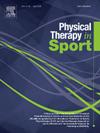Kinesiophobia is associated with lower extremity landing biomechanics in individuals with ACL reconstruction
IF 2.2
3区 医学
Q1 REHABILITATION
引用次数: 0
Abstract
Objectives
To evaluate relationships between patient-reported outcomes and lower extremity biomechanics associated with risk for second ACL injury among individuals with ACL reconstruction (ACLR).
Design
Cross-sectional study.
Setting
Research laboratory.
Participants
20 individuals with primary, unilateral ACLR (10 female, age = 20.1 ± 2.0 years, median time from surgery = 29.6 [IQR = 9.1–53.3] months).
Main outcome measures
Participants completed the International Knee Documentation Committee Subjective Knee Evaluation, Tampa Scale of Kinesiophobia (TSK-11), and Veterans RAND 12-Item Health Survey. Three-dimensional biomechanics were evaluated at peak vertical ground reaction force (vGRF) and as peak kinematic and kinetics within the first 100 ms of landing from a drop vertical jump.
Results
Higher TSK-11 scores associated with lesser hip flexion angles (r = −.723, P < .001), lesser knee flexion angles (r = .561, P = .010), and greater internal knee abduction moments (ρ = −.606, P = .005) at peak vGRF. These relationships remained significant when correcting for multiple tests and controlling for time from surgery and biological sex.
Conclusions
Kinesiophobia, but not self-reported knee function or health-related quality of life, is associated with aberrant landing biomechanics when the largest magnitudes of vertical force were applied to the knee. Individuals with greater kinesiophobia may adopt a stiffer landing profile with increased medial knee compartment loading, potentially increasing risk for second ACL injury.
前交叉韧带重建患者的运动恐惧与下肢着地生物力学有关
目的评估ACL重建(ACLR)患者报告的结果与与二次ACL损伤风险相关的下肢生物力学之间的关系。DesignCross-sectional研究。SettingResearch实验室。参与者20例原发性单侧ACLR患者(10例女性,年龄= 20.1±2.0岁,中位手术时间= 29.6 [IQR = 9.1-53.3]个月)。参与者完成了国际膝关节文献委员会主观膝关节评估、坦帕运动恐惧症量表(TSK-11)和退伍军人RAND 12项健康调查。三维生物力学在垂直地面反作用力峰值(vGRF)和垂直起跳落地前100 ms内的运动学和动力学峰值进行了评估。结果TSK-11评分越高,髋关节屈曲角度越小(r =−)。723, P <;.001),较小的膝关节屈曲角度(r = .561, P = .010),较大的膝关节内展力矩(ρ = -。606, P = .005)。这些关系在校正多个测试并控制手术时间和生理性别后仍然很重要。结论当膝关节受到最大垂直力时,皮肤恐惧与异常的着陆生物力学有关,而与自我报告的膝关节功能或健康相关的生活质量无关。运动恐惧症患者可能会采用更硬的着陆方式,增加膝关节内侧隔室负荷,这可能会增加第二次前交叉韧带损伤的风险。
本文章由计算机程序翻译,如有差异,请以英文原文为准。
求助全文
约1分钟内获得全文
求助全文
来源期刊

Physical Therapy in Sport
医学-康复医学
CiteScore
4.50
自引率
8.30%
发文量
125
审稿时长
39 days
期刊介绍:
Physical Therapy in Sport is an international peer-reviewed journal that provides a forum for the publication of research and clinical practice material relevant to the healthcare professions involved in sports and exercise medicine, and rehabilitation. The journal publishes material that is indispensable for day-to-day practice and continuing professional development. Physical Therapy in Sport covers topics dealing with the diagnosis, treatment, and prevention of injuries, as well as more general areas of sports and exercise medicine and related sports science.
The journal publishes original research, case studies, reviews, masterclasses, papers on clinical approaches, and book reviews, as well as occasional reports from conferences. Papers are double-blind peer-reviewed by our international advisory board and other international experts, and submissions from a broad range of disciplines are actively encouraged.
 求助内容:
求助内容: 应助结果提醒方式:
应助结果提醒方式:


